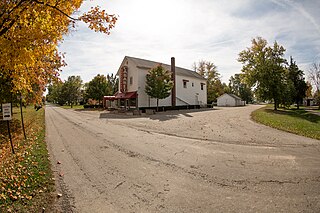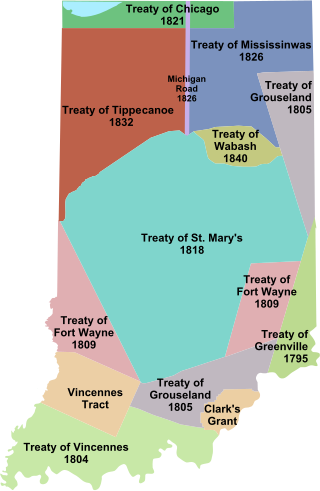
Shelby County is a county in the U.S. state of Indiana. As of the 2020 United States Census, the population was 45,055. The county seat is Shelbyville.

Madison County is a county in the U.S. state of Indiana. The 2020 census states the population is standing at 130,129. The county seat since 1836 has been Anderson, one of three incorporated cities within the county.

Franklin County is a county on the eastern border of the U.S. state of Indiana. In the 2020 United States Census, the county population was 22,785. The county seat is the town of Brookville. Franklin County is part of the Cincinnati, OH–KY–IN Metropolitan Statistical Area. The only incorporated city in Franklin County is Batesville, which lies mostly in adjoining Ripley County.

Decatur County is a county in the U.S. state of Indiana. As of the 2020 United States Census, the population was 26,472. The county seat is Greensburg.

Shelbyville is a city in Addison Township, Shelby County, in the U.S. state of Indiana and is the county seat. The population was 20,067 as of the 2020 census.

Noah Noble was the fifth governor of the U.S. state of Indiana from 1831 to 1837. His two terms focused largely on internal improvements, culminating in the passage of the Mammoth Internal Improvement Act, which was viewed at the time as his crowning achievement. His taxing recommendations to pay for the improvements were not fully enacted, and the project ultimately led the state to negotiate a partial bankruptcy only a few years later. The debacle led to a gradual collapse of the state Whig party, which never regained control of the government, and led to a period of Democratic control that lasted until the middle of the American Civil War. After his term as governor he was appointed to the Board of Internal Improvement where he unsuccessfully advocated a reorganization of the projects in an attempt to gain some benefit from them.

Robert Hanna Jr. is best known as one of the forty-three delegates to the 1816 Indiana Constitutional Convention and Indiana's third U.S. Senator after it achieved statehood in 1816. A native of Laurens County, South Carolina, he settled in the Indiana Territory shortly after it was established in 1800 and began his long career as a public servant in Brookville, Indiana. Hanna served as the first Franklin County sheriff (1809–20), as a brigadier general in the state militia, and as the U.S. Land Office registrar in Brookville and Indianapolis (1820–30). Hanna was appointed to fill the vacant seat in the U.S. Senate following the death of James Noble in 1831. Hanna served in the U.S. Senate from August 19, 1831, to January 3, 1832. After his return to Indianapolis, Hanna represented Marion County in the Indiana House of Representatives and in the Indiana Senate.
Strawtown is an unincorporated community in White River Township, Hamilton County, Indiana.
Blue Ridge is an unincorporated community in Liberty Township, Shelby County, in the U.S. state of Indiana.

Boggstown is an unincorporated community in Sugar Creek Township, Shelby County, in the U.S. state of Indiana.

Flat Rock is an unincorporated community in Washington Township, Shelby County, in the U.S. state of Indiana.
Fountaintown is an unincorporated community in Van Buren Township, Shelby County, in the U.S. state of Indiana.

Geneva is an unincorporated community in Noble Township, Shelby County, in the U.S. state of Indiana.
Gwynneville is an unincorporated community in Hanover Township, Shelby County, in the U.S. state of Indiana.
Marietta is an unincorporated community in Hendricks Township, Shelby County, in the U.S. state of Indiana.

Waldron is an unincorporated community and census-designated place in Liberty Township, Shelby County, in the U.S. state of Indiana.

Indian removals in Indiana followed a series of the land cession treaties made between 1795 and 1846 that led to the removal of most of the native tribes from Indiana. Some of the removals occurred prior to 1830, but most took place between 1830 and 1846. The Lenape (Delaware), Piankashaw, Kickapoo, Wea, and Shawnee were removed in the 1820s and 1830s, but the Potawatomi and Miami removals in the 1830s and 1840s were more gradual and incomplete, and not all of Indiana's Native Americans voluntarily left the state. The most well-known resistance effort in Indiana was the forced removal of Chief Menominee and his Yellow River band of Potawatomi in what became known as the Potawatomi Trail of Death in 1838, in which 859 Potawatomi were removed to Kansas and at least forty died on the journey west. The Miami were the last to be removed from Indiana, but tribal leaders delayed the process until 1846. Many of the Miami were permitted to remain on land allotments guaranteed to them under the Treaty of St. Mary's (1818) and subsequent treaties.
Freeport is an unincorporated community in Hanover Township, Shelby County, in the U.S. state of Indiana.
Prescott is an unincorporated community in Shelby Township, Shelby County, in the U.S. state of Indiana.
Rays Crossing is an unincorporated community in Union Township, Shelby County, in the U.S. state of Indiana.














